There is no denying the banjo is a ton of fun to play, and that’s probably why they’re once again growing in popularity. More instrument brands are starting to make them and some of the nicer models are selling out!
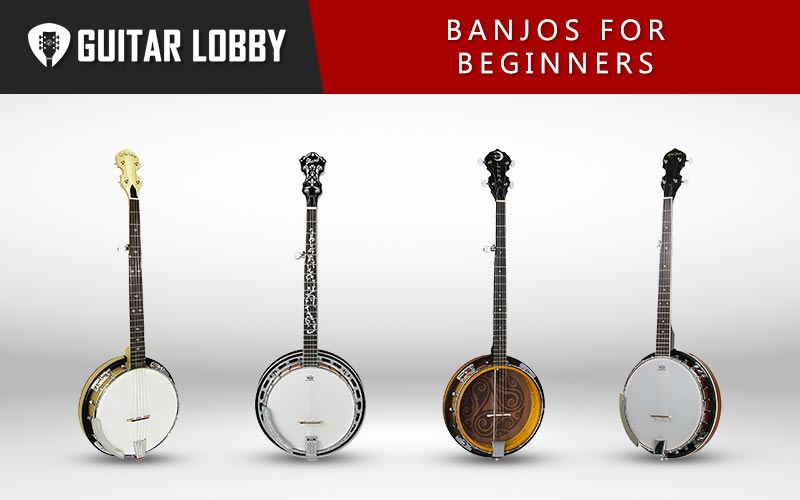
And while many readers may be here because of bluegrass, keep in mind that the banjo has so much more to offer. You can play Irish folk tunes, Americana, jazz, Dixieland, blues, rock, and really almost anything you want. The banjo was around 100 years before bluegrass and it has a rich musical history.
We’ll start this article by jumping straight into reviews on the best beginner banjos at each price point, but if you want to learn more about banjos before reading reviews, check out our banjo buying guide at the bottom of the page here.
| Name of Product | Image of Product | Description | Price Range | Full Review |
|---|---|---|---|---|
| 1. Jameson 5-String (Best Value) | 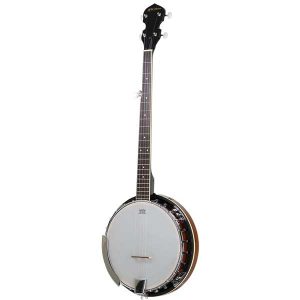 | Banjo Style: 5 string with resonator Top: Mahogany | $300 | Read Full Review Below |
| 2. Deering Goodtime 2 (Editor's Choice) | 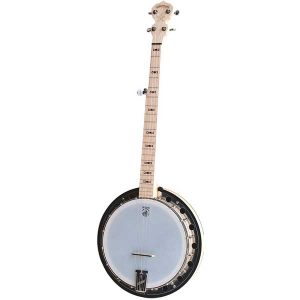 | Banjo Style: 5 string with resonator Top: Maple | $650 | Read Full Review Below |
| 3. Deering Goodtime (Best Under $500) | 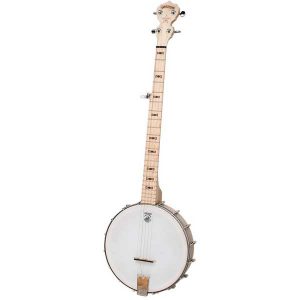 | Banjo Style: 5 string open back Top: Maple | $500 | Read Full Review Below |
| 4. Rouge B30 (Best Cheap Banjo) | 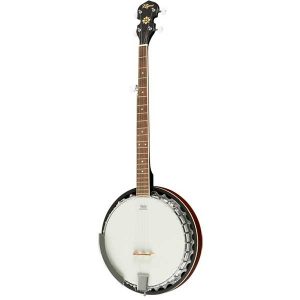 | Banjo Style: 5 string with resonator Top: Nato | $200 | Read Full Review Below |
| 5. Epiphone MB 100 5 String | 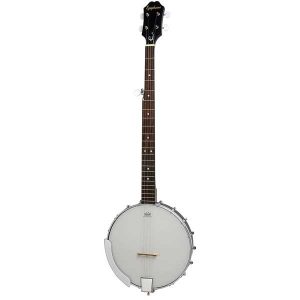 | Banjo Style: 5 string open back Top: Mahogany | $230 | Read Full Review Below |
| 6. Ibanez B200 5 String | 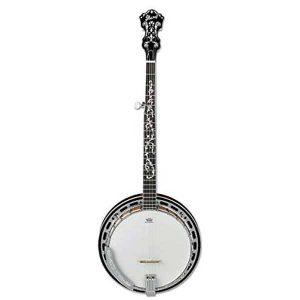 | Banjo Style: 5 string with resonator Top: Mahogany | $450 | Read Full Review Below |
| 7. Oscar Schmidt OB3 5 String | 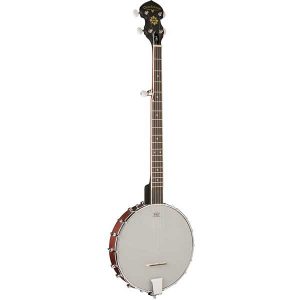 | Banjo Style: 5 string open back Top: Mahogany | $250 | Read Full Review Below |
| 8. Recording King RKT-05 4 String Tenor | 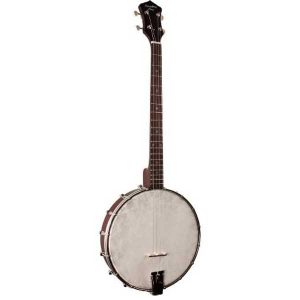 | Banjo Style: 4 string open back tenor Top: Maple | $230 | Read Full Review Below |
| 9. Rover PB-20P 4 string Plectrum | 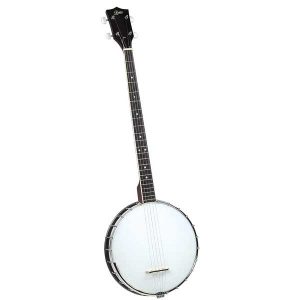 | Banjo Style: 4 string plectrum Top: Mahogany | $240 | Read Full Review Below |
| 10. Gold Tone – CC 100R 5 String | 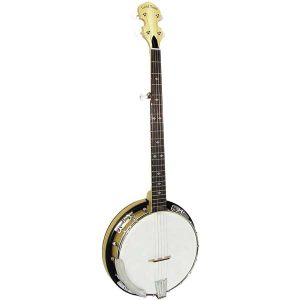 | Banjo Style: 5 string banjo with resonator Top: Maple veneer | $560 | Read Full Review Below |
| 11. Dean Backwoods 6 String Banjo Guitar | 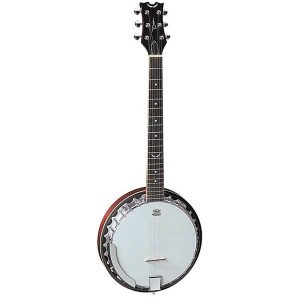 | Banjo Style: 6 string hybrid Top: Mahogany | $350 | Read Full Review Below |
| 12. Pyle 5 String | 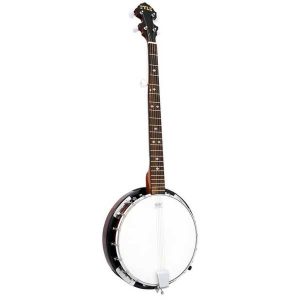 | Banjo Style: 5 string with resonator Top: Mahogany | $200 | Read Full Review Below |
| 13. Gold Tone Cripple Creek 4 String Irish Tenor Banjo |  | Banjo Style: 4 string Irish tenor Top: Maple | $580 | Read Full Review Below |
| 14. Morgan Monroe Deluxe Duelington 5 String | 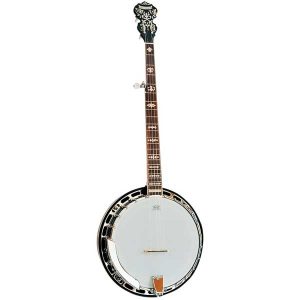 | Banjo Style: 5 string with resonator Top: Mahogany | $680 | Read Full Review Below |
| 15. Vangoa 5 String | 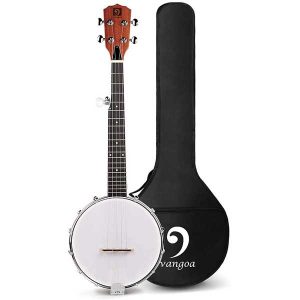 | Banjo Style: 5 string with resonator Top: Mahogany | $200 | Read Full Review Below |
| 16. Stagg BGM30 5 String | 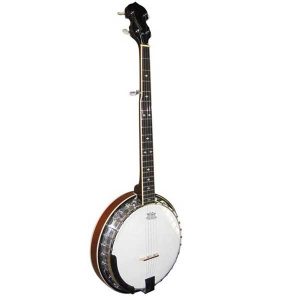 | Banjo Style: 5 string with resonator Top: Mahogany | $320 | Read Full Review Below |
| 17. ADM 5 String | 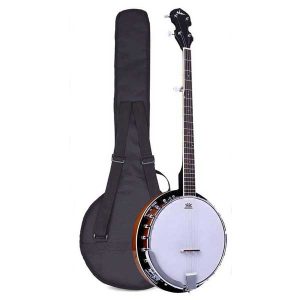 | Banjo Style: 5 string with resonator Top: Sapele | $190 | Read Full Review Below |
| 18. Savannah SB-060 5 String Travel Banjo | 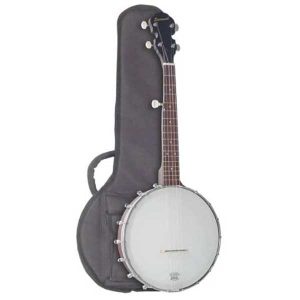 | Banjo Style: 5 string travel Top: Maple | $300 | Read Full Review Below |
| 19. Trinity River 4 String Tenor Banjo | 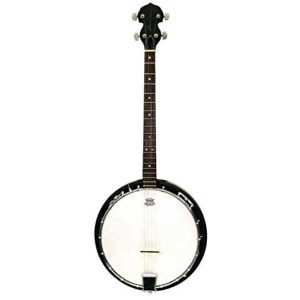 | Banjo Style: 4 string tenor Top: Mora | $260 | Read Full Review Below |
| 20. Luna Celtic 5 String | 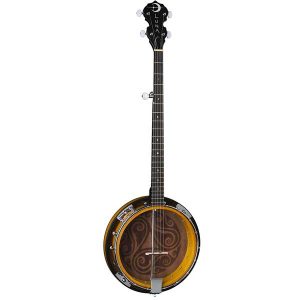 | Banjo Style: 5 string with resonator Top: Mahogany | $400 | Read Full Review Below |
Here are the Best Banjos for Beginners
1. Jameson 5-String Banjo (Best Value)
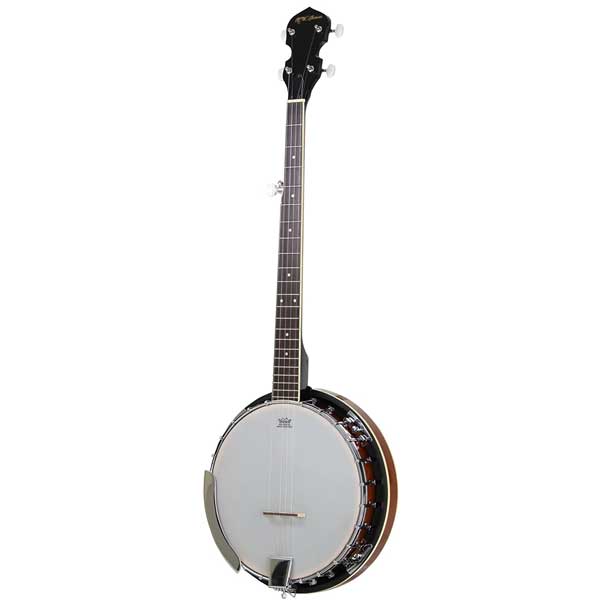
| Estimated Price | $300 |
| Banjo Style | 5 string with resonator |
| Top | Mahogany |
| Back and Rim | Mahogany |
| Neck | Maple |
| Finish | High Gloss |
| Fret Count | 22 |
| Country of Origin | USA |
My Review: If you’re a beginner looking to play the banjo, the Jameson 5-String is almost impossible to beat for the money. RW Jameson is a company out of Nashville that makes quality guitars and banjos at a fair price. This 5 string banjo has a great reputation and considering the price, it’s our top pick as far as value.
Going under $300 will likely lead to action and intonation issues, but that’s not the case here. 5 strings are also generally more expensive, but Jameson has found the right materials to keep the price down while still producing a great banjo. This is such a popular banjo that it is common to see it temporarily sold out. It’s an amazing looking banjo with excellent action (if set upright). It’s no surprise why this is one of the best-selling banjos of all time for good reasons.
Key Features: This banjo is 38 inches long and weighs about 10 pounds. It has 24 brackets with 5 geared tuners and a bound closed resonator back. The neck is slim for easy playing and it has an adjustable truss rod for future neck adjustments.
Build Materials: The neck is maple and the top, back, and sides are mahogany. It also has a maple bridge, a nickel-plated armrest, and an adjustable tailpiece.
Who Will Use This the Most: Complete beginners to the banjo will find this a suitable instrument to start on. The price won’t kill you and then you can find out if you will stick with it or not!
Bottom Line: If this is your budget get it. However, if you can hold out save for a Deering or Gold Tone.
2. Deering Goodtime 2 (Editor’s Choice)
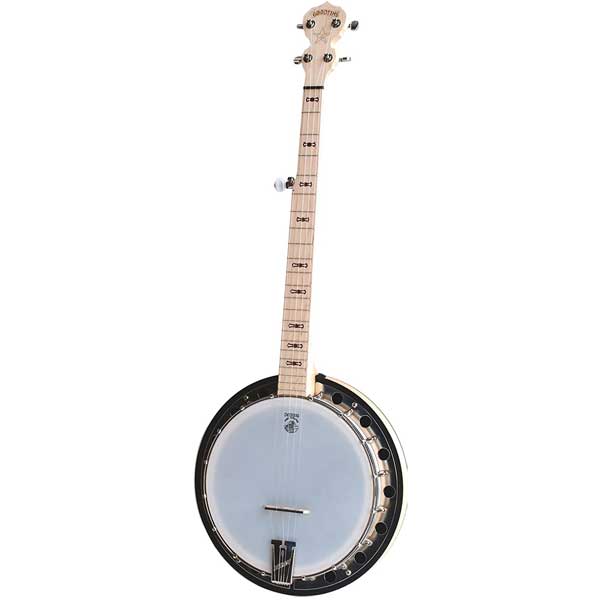
| Estimated Price | $670 |
| Banjo Style | 5 string with resonator |
| Top | Maple |
| Back and Rim | Maple |
| Neck | Slender rock Maple |
| Finish | Durable Satin |
| Fret Count | 22 |
| Country of Origin | USA |
My Review: This is really one of the best banjos out there, period. Deering banjos are made outside of San Diego and they are one of the most popular brands around. This banjo isn’t just great for a beginner, it is great as they advance. The Deering Goodtime is worthy of being taken out on stage; it is a high-quality banjo.
The Deering Goodtime 2 is a 5 string with a resonator and the regular Deering Goodtime is a 5 string without one. This 5 string is beautiful and durable, a banjo that will last a long time if taken care of right. The neck is just right to allow fast and easy playing and the sound is fantastic. It is no wonder most people love the brand. The main reason that people don’t buy this is budget restrictions.
Key Features: It is 38 inches and weighs about 6 pounds. There are sealed geared tuners and a single bound maple resonator. This gives the banjo a very rich and warm tone. And it has the Deering fiddle-shaped peghead.
Build Materials: Most of the wood is made of maple and the top is frosted mylar. The neck in particular is blonde and slender rock maple. The rim is 3 ply maple, the bridge is that and ebony, and it also has an adjustable tailpiece.
Who Will Use This the Most: This is a great banjo all around. Beginners to advanced players will be happy with it. Keep in mind a nice banjo like this will need to be protected and maintained.
Bottom Line: If you have the budget get the 4 or 5 string Deering Goodtime, you will be as happy as all the other customers! If the price isn’t a major factor for you, this is my choice as the best beginner banjo out there right now.
3. Deering Goodtime (Best Under $500)
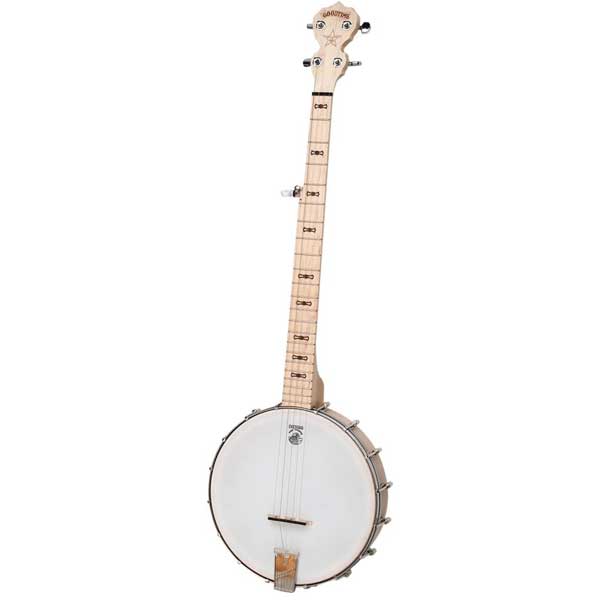
| Estimated Price | $500 |
| Banjo Style | 5 string open back |
| Top | Maple |
| Back and Rim | Maple |
| Neck | Rock maple |
| Finish | Durable satin |
| Fret Count | 22 |
| Country of Origin | USA |
My Review: If you want a great 5 string banjo out there but no resonator then the Deering Goodtime is a great option. It isn’t cheap but it is a wonderful model that has plenty of fans and great reviews. And it is lighter than many other cheaper models despite its powerful sound. It is a lovely looking instrument that looks and feels professional.
If you aren’t sure about the resonator or not then it may be wise to save a little more and get the Goodtime 2. That way you don’t spend $500 and realize you want a regular resonator backed banjo. But that will likely be the only negative aspect of the purchase as you will be very happy with the Goodtime.
Key Features: It is about 30 inches and 5 pounds and comes with a triangle box for carrying. It has the Deering fiddle-shaped peghead, hardwood bow tie inlays, and a satin finish.
Build Materials: A slender rock maple neck, maple rim, and high crown Remo head. The bridge is made of maple and ebony with the Deering patented tailpiece.
Who Will Use This the Most: People who want a great 5 string banjo without the resonator.
This is great to take camping and to jams.
Bottom Line: Deering is a great brand and if anything goes wrong you will be covered by a warranty. In my opinion, this is the best banjo for beginners under 500 considering its value and overall quality.
4. Rouge B30 (Best Cheap Banjo)
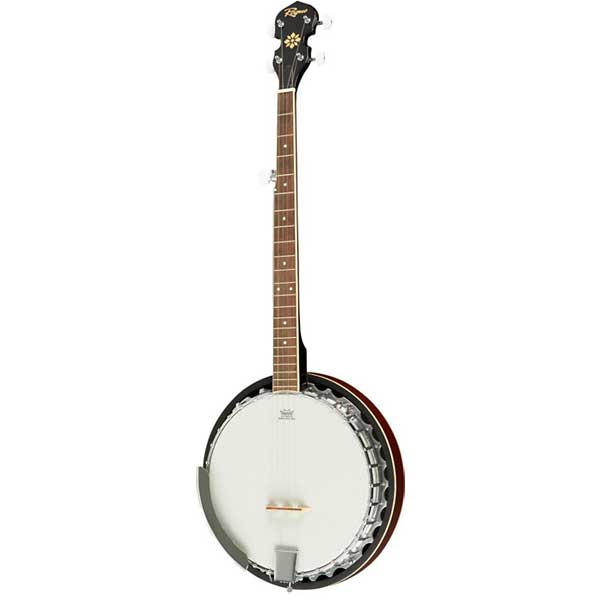
| Estimated Price | $200 |
| Banjo Style | 5 string with resonator |
| Top | Nato |
| Back and Rim | Nato |
| Neck | Nato |
| Finish | Gloss |
| Fret Count | 20 |
| Country of Origin | South Korea |
My Review: Rogue is a company owned by Sunbo in South Korea, they make low priced guitars, banjos, mandolins, and their lap steel is actually not a bad deal. Like most low priced models they have a mix of folks who are fine with their Rogue instruments, and others who’ve had bad experiences. Spending $200 on a 4 string isn’t so bad, but for a 5 string, you are pushing it.
When you get a decent Rogue B30 it isn’t terrible sounding and you can get by, but if you have a problem it can mean no progress. This is simply a banjo that is bought based on budget and often not the best choice.
Key Features: It is 39 inches long and weighs about 8 pounds.
Build Materials: The neck and body are made of nato and it has 30 brackets with an aluminum ring. There is also a chrome-plated armrest and tuners.
Who Will Use This the Most: Buyers who might be trying to be a little too cheap are taking their chances at this price range.
Bottom Line: The lap steels they sell are good, but only if you change the pick-up. There is always a caveat. Pick a better brand.
5. Epiphone MB 100 5 String
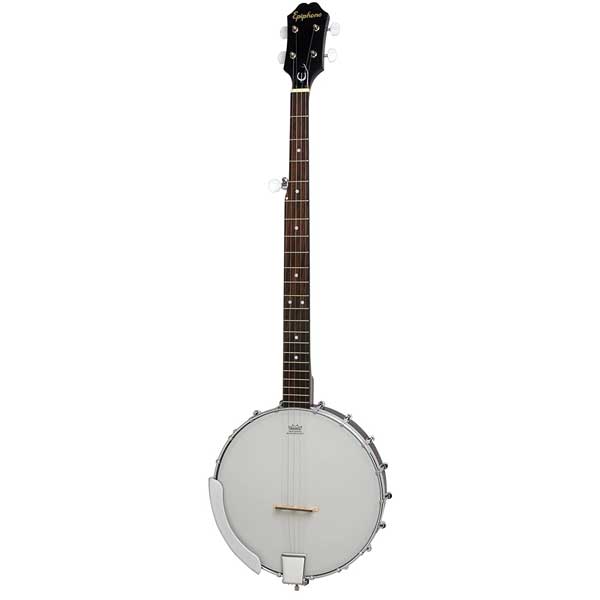
| Estimated Price | $230 |
| Banjo Style | 5 string open back |
| Top | Mahogany |
| Back and Rim | Mahogany |
| Neck | Mahogany |
| Finish | Natural |
| Fret Count | 22 |
| Country of Origin | China |
My Review: When you buy below $300 you will typically sacrifice material and build quality, along with other potential problems. But sometimes you get lucky and find a gem that’s really solid and plays well. While Epiphone is now owned by the same company as Gibson their founders’ first patent was for a banjo.
The banjo without a resonator is not the most complicated instrument so a lower price is expected. If you do buy this banjo just make sure the action and intonation are working well when you get it. As long as there are no major problems it is a reasonable banjo. And the fact that it has an armrest at this price is nice because they do come in handy.
Key Features: A very simple open-back banjo that is 41 inches and weighs 4 pounds.
Build Materials: It has a mahogany neck and body with a Remo head. Along with a genuine rosewood fretboard, a natural finish, and chrome hardware.
Who Will Use This the Most: For those with a lower budget, or even people needing a lighter weight banjo this will be perfect. If you don’t need or like the resonator then don’t get it!
Bottom Line: As long as you check to make sure the banjo has great action, intonation, and no major problems it should make a fine first-time practice instrument.
6. Ibanez B200 5 String
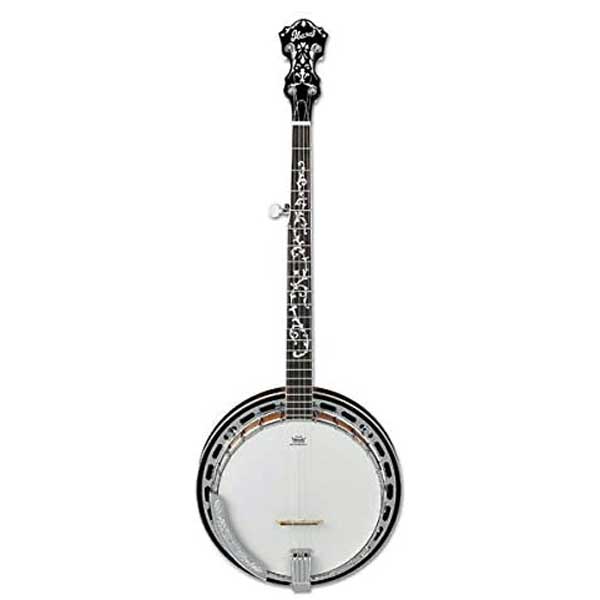
| Estimated Price | $450 |
| Banjo Style | 5 string with resonator |
| Top | Mahogany |
| Back and Rim | Basswood |
| Neck | Mahogany |
| Finish | Gloss |
| Fret Count | 22 |
| Country of Origin | Japan |
My Review: This has a nice size price tag and along with that comes a banjo with a little bit of flair. If you are looking for a fancier looking design this may be the banjo for you. Ibanez is a maker from Japan known for heavy metal guitars, but they also build other instruments. They used to build banjos and recently got back into doing it again.
This particular model has a solid build and loud sound, the main selling point is really the artwork and style. Because of all that flair, it is rather heavy and might need a nice padded strap. However, with it, the banjo looks a lot pricier than it really might be. An image you may wish to project on stage, nothing wrong with that!
Key Features: This banjo is almost 41 inches and 13 pounds, it is heavy! There is a nice ABS inlay on the fretboard and chrome with etching.
Build Materials: It has a neck and resonator of mahogany and basswood for the double rim. The rim has a 24 lug configuration with a rolled brass tone ring. Most of the hardware, armrest, and clamshell tailpiece are all chrome.
Who Will Use This the Most: Ibanez is looking for a customer who wants a hefty banjo that will be durable and look good on stage.
Bottom Line: Despite Ibanez being associated with guitars you can trust this will be a good banjo if you like the style.
7. Oscar Schmidt OB3 5 String
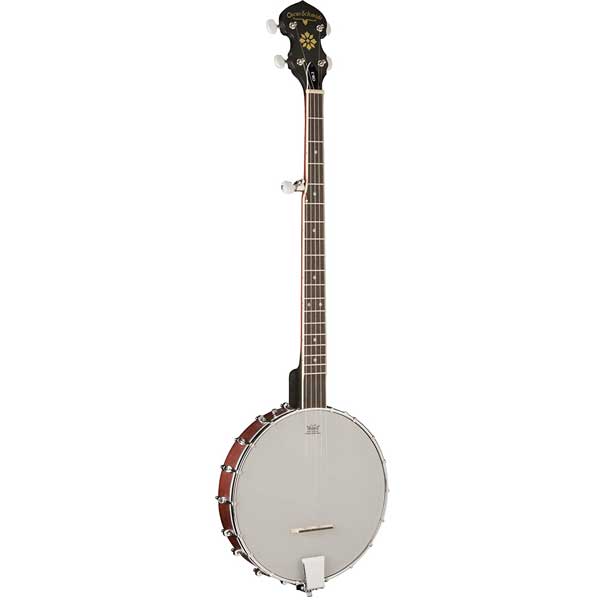
| Estimated Price | $250 |
| Banjo Style | 5 string open back |
| Top | Mahogany |
| Back and Rim | Mahogany |
| Neck | Mahogany |
| Finish | Gloss |
| Fret Count | 18 |
| Country of Origin | USA |
My Review: This open back 5 string banjo is made by Oscar Schmidt. A company known for great folk instruments since the 1800s and now owned by Washburn. Many of their most popular models aim at the high end of many low budgets. While they have their occasional lemon off the factory floor for the most part they produce worthy student instruments.
This banjo is very basic with no bells and whistles. In fact, it is easy to look at and think what a simple instrument, why is it over $200? But remember even if we want basic it needs to be playable. If the resonator isn’t necessary and you just want an affordable open back banjo this OB3 is fine.
Key Features: It is 46 inches and weighs 8 pounds. It has 18 brackets with a Remo head, a multi-inlay gloss finish fretboard, and a satin finish on the pot.
Build Materials: The fretboard is rosewood and the rest of the wood is mahogany.
Who Will Use This the Most: This is perfect for those on a budget who don’t need a resonator, no-frills, and want something simple. A great instrument to take camping also!
Bottom Line: Considering it has no resonator and Oscar Schmidt has a great reputation this simple 5 string banjo will be a great buy if that is the style you like.
8. Recording King RKT-05 4 String Tenor
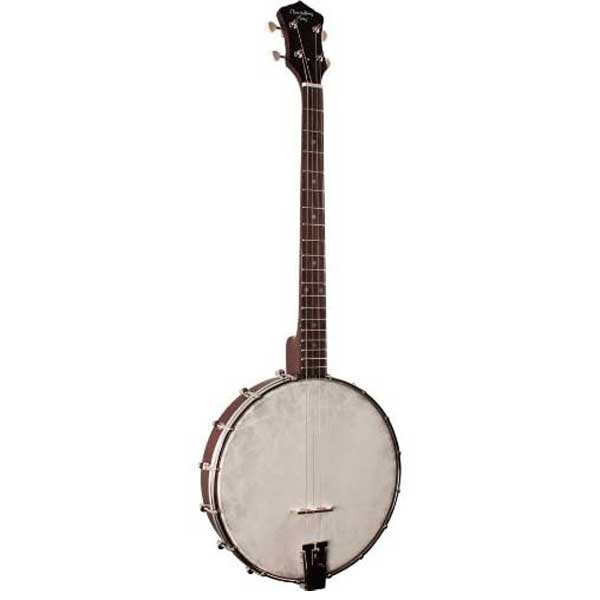
| Estimated Price | $230 |
| Banjo Style | 4 string open back tenor |
| Top | Maple |
| Back and Rim | Maple |
| Neck | Maple |
| Finish | Natural |
| Fret Count | 19 |
| Country of Origin | China |
My Review: Recording King began as a musical instrument brand for Montgomery Ward, a once huge department store chain in the USA. They still make regular guitars, resonator guitars, and banjos. This model here is made to look like a simple 4 string banjo from 100 years ago, even with the head appearing to be a little worn and used. Ironically they are aiming towards a depression-era look, which was the time period when the banjo historically crashed in popularity!
This open-back banjo is usually tuned CGDA and is also great for playing Dixieland and Celtic music styles. Just like the Oscar Schmidt it is lower priced because it is a very simple banjo. Despite it looking so basic and rustic it has a very loud sound with great projection. At this budget range, you cannot expect perfection, but these tenor banjos will be suitable for first-time players. Of course not having the fifth string and larger scale it may limit you in some genres.
Key Features: It is 35 inches and weighs about 5 pounds. A narrow 19 fret neck and 16 brackets holding down a Remo fiberskyn head.
Build Materials: The neck is maple with an adjustable truss rod. The rim is also maple and the fretboard is rosewood.
Who Will Use This the Most: For those who don’t want a bluegrass-style banjo this tenor banjo will be great. It is also very easy to take out and about if you are always on the move.
Bottom Line: If you like multiple styles of music and want something affordable now this Recording King model is an OK buy.
9. Rover PB-20P 4 string Plectrum
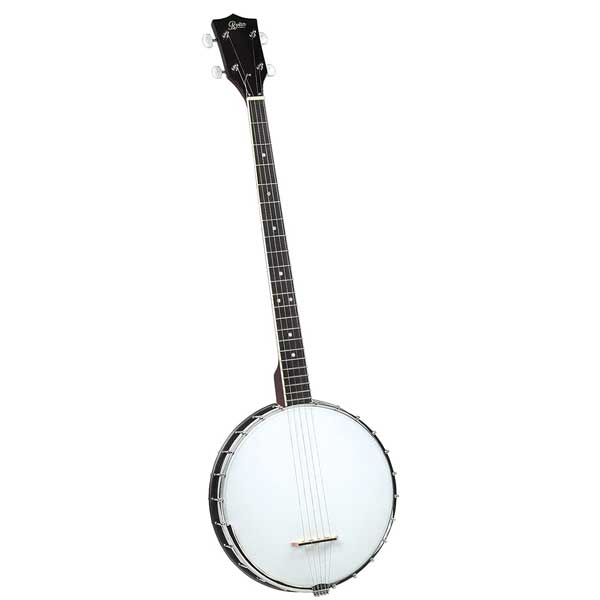
| Estimated Price | $240 |
| Banjo Style | 4 string plectrum |
| Top | Mahogany |
| Back and Rim | Mahogany |
| Neck | Mahogany |
| Finish | Metallic gun grey |
| Fret Count | 22 |
| Country of Origin | USA |
My Review: Remember that a plectrum banjo is a simple 4 string that is played with a pick or plectrum. This makes for a distinctly different rhythm than the common Scruggs or clawhammer style playing. This brand Rover is made by Saga, a company that makes a variety of folk instruments and violins. If you are interested in the plectrum banjo and folk music you will likely find other appealing instruments at Saga.
Once again the open back and 4 string models are very basic and spending over $200 is a working budget. The tuning is in CGBD, so you are playing in classic banjo tuning. Of course, you can change the tuning just pay attention to string gauges, tension, and the nut slots that they fit in. This is another banjo with no frills or anything special.
Key Features: It is 38 inches and 4 pounds, very light and easy to hold. With 24 flat hooks, a rim made of composite, and the head of frosted mylar. There is also a deluxe Vega-style armrest, but it is rather small.
Build Materials: The neck is mahogany, and the fretboard is made of East Indian rosewood, nothing spectacular compared to regular rosewood.
Who Will Use This the Most: Perfect for the minimalist banjo player who wants to play in old-time 4 string plectrum style.
Bottom Line: Another low price brand that is fine to learn on as long as you check the intonation and build in the beginning.
10. Gold Tone CC 100R 5 String
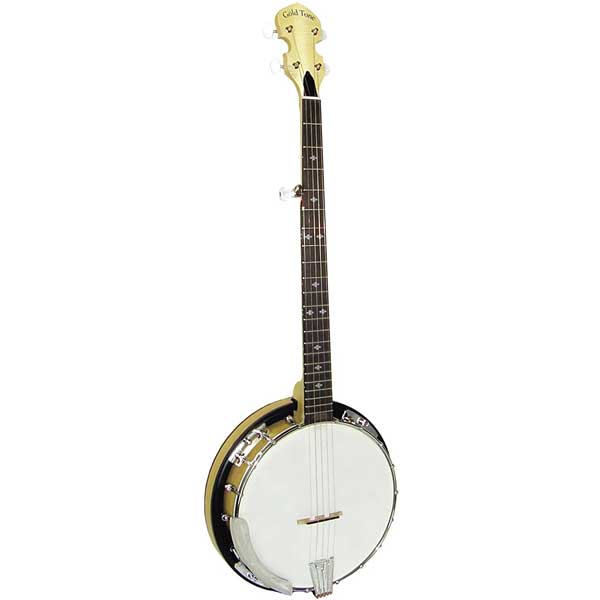
| Estimated Price | $560 |
| Banjo Style | 5 string banjo with resonator |
| Top | Maple veneer |
| Back and Rim | Maple |
| Neck | Maple |
| Finish | Natural gloss |
| Fret Count | 22 |
| Country of Origin | USA |
My Review: Gold Tone is another one of the reliable and known banjo brands on the market. It started in Florida in the early ’90s and has been pretty popular since. This banjo looks completely different than any we have seen so far. Besides its goldish color, it has all the same features as most 5 string resonator banjos. This is a banjo that you will look at and know right away whether it is appealing or not.
The one feature Gold Tone often touts a low action setup for you when it is ordered. This one of the best things a beginner can have, that way you know you just need to touch up the tuning. If you want a great banjo to start playing bluegrass or folk this will be it this will last as an advanced instrument. Gold Tone has some great banjos and you want to make sure you get a case!
Key Features: It is 39 inches and about 7 pounds. There are 18 brackets with a rolled brass ring. There are snowflake inlays and a terminator tailpiece. It also comes with an engraved armrest and a bridge with maple and ebony cap.
Build Materials: The neck and the resonator are made of maple and it has a brass truss rod. The headstock is a maple veneer and the fretboard rosewood.
Who Will Use This the Most: If you are in the market for a quality banjo and want more flash than a Deering, this Gold-Tone will be perfect.
Bottom Line: If you have the budget buy a nice banjo that will last you. That way you know your learning will not be impeded by low quality issues.
11. Dean Backwoods 6 String Banjo Guitar
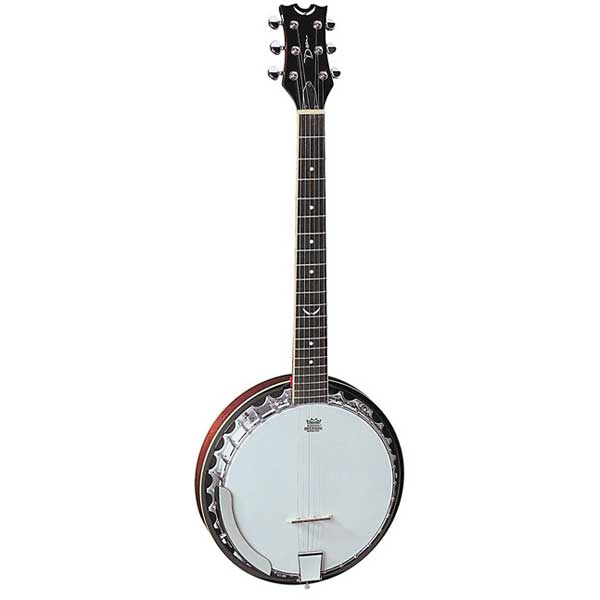
| Estimated Price | $350 |
| Banjo Style | 6 string hybrid |
| Top | Mahogany |
| Back and Rim | Mahogany |
| Neck | Mahogany |
| Finish | Classic Black |
| Fret Count | 21 |
| Country of Origin | China |
My Review: This is the hybrid guitar and banjo model built for those seeking to make the crossover. Dean is normally known for their electric heavy metal type guitars, but they also make acoustic basses, mandolins, and banjos. Another company aiming for the high end of the lower budget, which means they usually have decent beginning instruments. This one is sold as a guitar tuning with the banjo sound, mainly coming from the normal resonator and head.
It is nice and easy to play if you are a guitar player as there is no transition and you are playing the same chords. If you wish to jump right into bluegrass playing this will get you started. This hybrid is actually good to have for jamming situations as someone will always likely know how to play the guitar compared to a banjo.
Key Features: It has a dual-action truss rod, pearl inlays, and a Remo head. The Grover tuners and nut are set for guitar tuning and the finish is classic black.
Build Materials: The C shaped neck and body are made of mahogany and the fretboard is rosewood. The bridge is a mixture of maple and black walnut.
Who Will Use This the Most: If you are looking to play a real banjo then this isn’t the right banjo to buy. If you play guitar and don’t want a hassle, then this is perfect.
Bottom Line: A nice entry model for those looking at hybrid banjo guitars.
12. Pyle 5 String
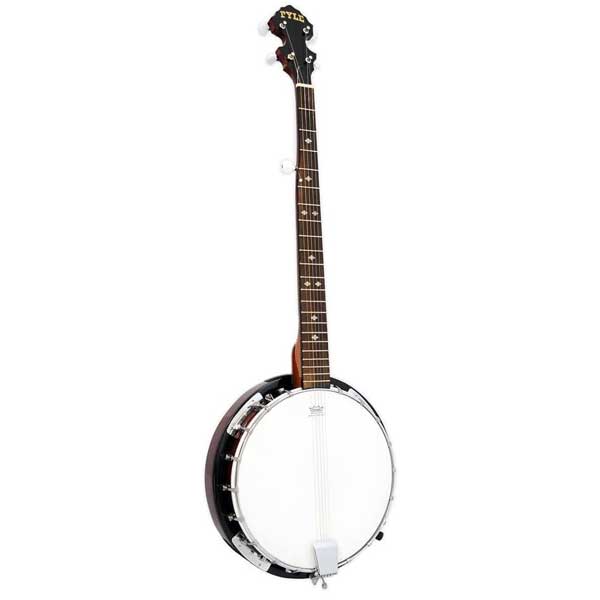
| Estimated Price | $200 |
| Banjo Style | 5 string with resonator |
| Top | Mahogany |
| Back and Rim | Shabili |
| Neck | Mahogany |
| Finish | Polished rich wood |
| Fret Count | 22 |
| Country of Origin | USA |
My Review: Pyle started in the 1960s making high quality speakers and eventually branched out into making instruments. They have higher priced banjos but this model here is a 5 string with a resonator which is barely under the $200 mark. At that price, you know it is going to be popular. The resonator is much smaller compared to most other 5 strings.
This banjo has great reviews for the most part, but it also has its share of complaints. You are taking a risk with getting a neck or intonation problem. Assuming you get one with no problems it will be suitable to start learning on. The problem is as a new student you won’t know until it is too late if there are any issues.
Key Features: It is about 39 inches long and 7 pounds which is light for a 5 string. It comes with a truss rod and adjustment tool and white jade machine head tuners.
Build Materials: It is made of shabili and maple wood with a Remo drumhead.
Who Will Use This the Most: This is the lowest priced 5 string resonator on the list if you are looking for the cheapest model here.
Bottom Line: At this price, you pretty much get what you pay for. If you’re looking for the best banjo for beginners and are on a tight budget this should be a top contender, but personally, I would go with the Rogue B30 reviewed above over this model.
13. Gold Tone Cripple Creek 4 String Irish Tenor Banjo
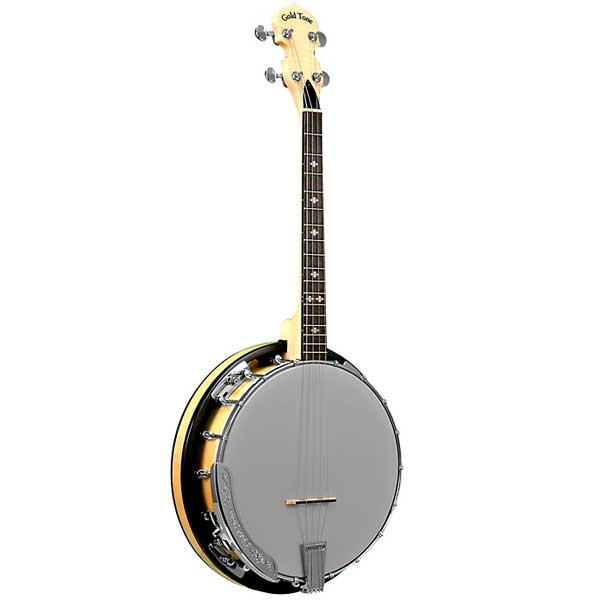
| Estimated Price | $580 |
| Banjo Style | 4 string Irish tenor |
| Top | Maple |
| Back and Rim | Maple |
| Neck | Maple |
| Finish | Natural gloss |
| Fret Count | 17 |
| Country of Origin | USA |
My Review: If you have no interest in bluegrass and want to take a different approach try an Irish tenor banjo. You’ll notice immediately the neck is smaller and it only has 4 strings. You play it with a pick, it is tuned GDAE, and you mostly play traditional Irish tunes. And because this is Gold Tone you know it is a quality banjo.
Besides people particularly interested in traditional Irish music this banjo is also great for those involved in Renaissance fairs, camping, and situations where a huge 5 string banjo is not necessary.
Key Features: It is 32 inches and 5 pounds with a Gold Tone engraved armrest. There is a snowflake inlay, natural gloss finish, and rolled brass tone ring.
Build Materials: The neck and resonator are maple, and the bridge is maple and ebony. There is a two-way adjustable truss rod and guitar styled sealed tuners.
Who Will Use This the Most: If you want to play banjo and have no interest in bluegrass and want to be unique try this tenor banjo and play some Irish folk music.
Bottom Line: Another beautiful looking and great sounding instrument by Gold Tone.
14. Morgan Monroe Deluxe Duelington 5 String
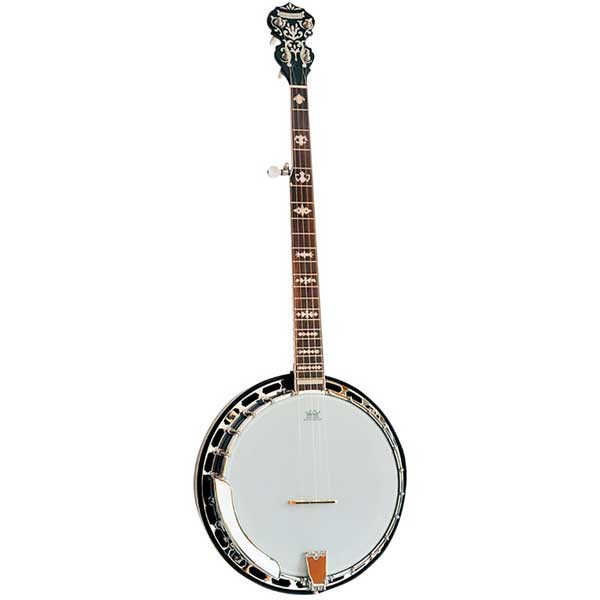
| Estimated Price | $680 |
| Banjo Style | 5 string with resonator |
| Top | Mahogany |
| Back and Rim | Mahogany |
| Neck | Mahogany |
| Finish | High gloss |
| Fret Count | 22 |
| Country of Origin | USA |
My Review: Morgan Monroe is a company that doesn’t have much on its website aside from the mandolins and banjos they sell (they even make a mandocello, now that is unique!). This is a high quality model that looks like it is pricey. If you want a great instrument to play that is flashy and nice looking, Morgan Monroe is worth checking out.
Unlike other major brands, there are not a ton of reviews out there for Morgan Monroe, but the ones that exist seem to be happy customers. If you have this kind of budget then it is likely you want something functional and beautiful. If the Deering and Gold Tone do not appeal to you aesthetically then you may want to look into this model here.
Key Features: It is 42 inches and 6 pounds, one of the longest banjos on the list so far. There are 24 brackets, an adjustable tailpiece, and a High Crown Remo head. With mother of pearl inlay, a black overlay peghead, ivoroid binding, and a chrome armrest.
Build Materials: It has a mahogany neck and resonator with a blackwood fretboard. 24 brackets with hardware that is nickel plated and the bridge made of maple and ebony.
Who Will Use This the Most: If you have this budget and you want a great 5 string banjo with a resonator, check this model out and it may appeal to you.
Bottom Line: So far Morgan Monroe seems to be a good brand with some very interesting and pretty instruments.
15. Vangoa 5 String Mini
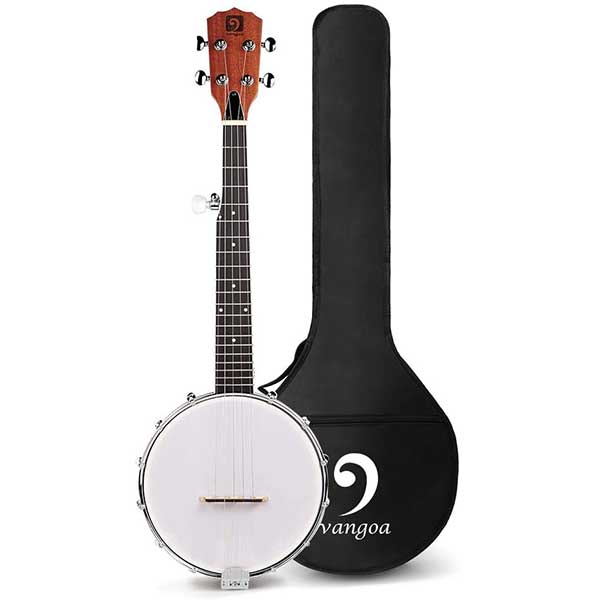
| Estimated Price | $120 |
| Banjo Style | 5 string open back mini |
| Top | Mahogany |
| Back and Rim | Mahogany |
| Neck | Mahogany |
| Finish | Natural |
| Fret Count | 20 |
| Country of Origin | China |
My Review: This banjo is not full size, which is why it has such a low price tag. Vangoa is another new company breaking into the low priced instrument market. This is included on the list because it does have many great reviews so there are clearly some happy customers. It does have a different scale than other banjos, but it will still give you that bluegrass sound. Just in mini form!
These mini banjos are known for having great action and they do come with truss rods and wrenches if you have to do any adjusting. Of course, the problem is if you are a beginner you really won’t know what you are doing. If you need something small and cheap for camping or kids, this is fine. But don’t attempt to learn on this small of a banjo, find a standard-sized model.
Key Features: It is 27 inches and 5 pounds and has an adjustable neck with 13 brackets. It also comes with a tuner, strap, Allen key, bracket wench, soft bag, and strings. It also has a special pickup that can be easily installed if the player wants to plug it in.
Build Materials: It has a mahogany neck and sides and a walnut fretboard.
Who Will Use This the Most: People who don’t want to commit to a full sized banjo or the budget involved.
Bottom Line: It may make a great little banjo to take camping. A lot of people seem to really like it!
16. Stagg BGM30 5 String
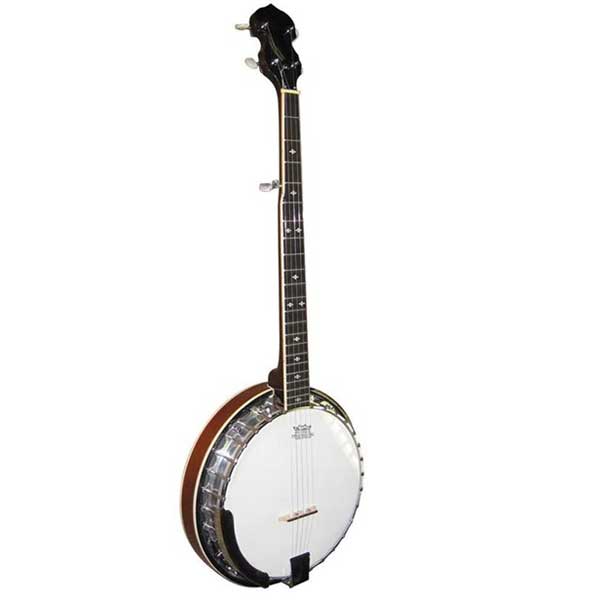
| Estimated Price | $320 |
| Banjo Style | 5 string with resonator |
| Top | Mahogany |
| Back and Rim | Mahogany |
| Neck | Mahogany |
| Finish | Gloss |
| Fret Count | 22 |
| Country of Origin | China |
My Review: Stagg is a 25 year old Japan brand that makes a variety of instruments especially guitars and banjos. They have similar quality products as Dean and Oscar Schmidt, and here is a great 5 string banjo with a resonator in the $300 range. It is definitely a little bland looking, but they are more worried about functionality than looks.
This Stagg is a decent student model and pricey enough to get a case for it. If you are looking to get into bluegrass or old-timey folk music this may be the banjo for you. This brand is common in local music stores so you may get lucky and find somewhere close to play them and see if they are the right sound and fit.
Key Features: It is 40 inches and about 4 pounds with a nickel-plated brass armrest. The resonator and neck have Pearloid cover inlays. The tuners are open gear Pearloid knobs and the tailpiece is nickel-plated brass.
Build Materials: The neck and body are mahogany and the fretboard rosewood. And an all cast metal pot with ivoroid cream binding.
Who Will Use This the Most: This is a better budget for a 5 string with a resonator, try to stick to this price and not go lower.
Bottom Line: Stagg makes decent student instruments and they have pretty good reviews for the most part.
17. ADM 5 String
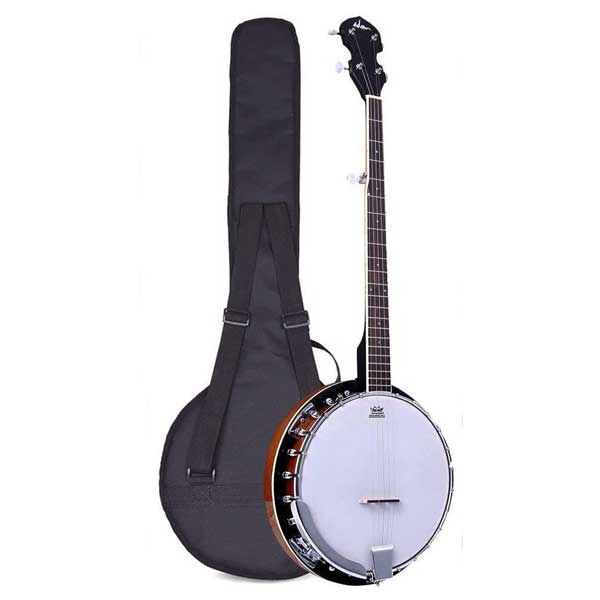
| Estimated Price | $190 |
| Banjo Style | 5 string with resonator |
| Top | Sapele |
| Back and Rim | Mahogany |
| Neck | Sapele |
| Finish | Gloss |
| Fret Count | 22 |
| Country of Origin | China |
My Review: The other super cheap 5 string banjo with a resonator and it only made the list as it has a lot of reviews. If you notice people aren’t too happy as they are probably getting a subpar 5 string. This company ADM is another mass producer of instruments.
In all the instruments that they build their goal is to capture the lowest cost category so choosing this one may not be the best idea. But if you are going to go for it at least check the instrument thoroughly when you get it. Make sure the action and intonation work!
Key Features: It is 41 inches and a little under 9 pounds. It has 24 brackets, an adjustable hinged tailpiece, and a chrome-plated armrest. It also comes with a gig bag, tuner, extra string, a strap, and 3 picks.
Build Materials: The wood is laminated Sapele and mahogany for the resonator, maple for the fretboard, and a polyurethane head (not a Remo like others).
Who Will Use This the Most: It is these lower-cost items with accessories that are often bought as gifts. Find a better brand to give if so.
Bottom Line: Another risky buy that is up to you if you want to make it or not.
18. Savannah SB-060 5 String Travel Banjo
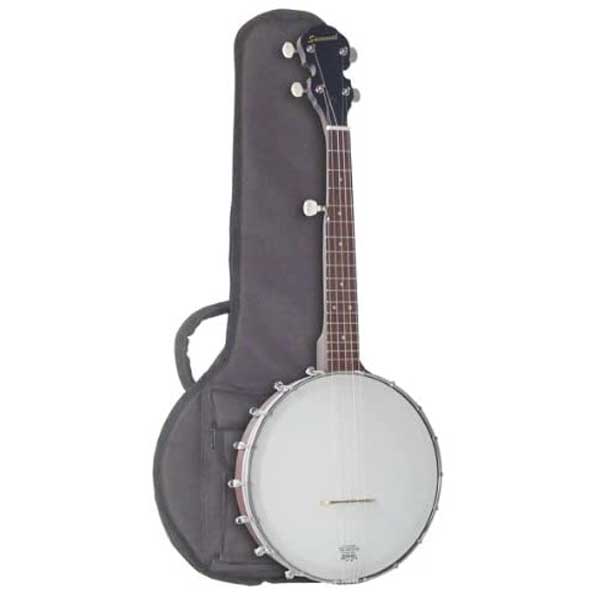
| Estimated Price | $300 |
| Banjo Style | 5 string travel |
| Top | Maple |
| Back and Rim | Maple |
| Neck | Mahogany |
| Finish | 17 |
| Fret Count | Natural wood |
| Country of Origin | USA |
My Review: To be clear this is a travel sized open-back banjo, so if you do buy it because you need a smaller size keep in mind it will be a little different to learn. It is tuned C, G, C, E, G which is an open C instead of the normal open G tuning. Generally, this is a better buy for someone who already has a banjo and wants a travel size.
However you may find you really want something small, but not a 4 string tenor banjo. In that case, this is a fine substitute. It is a decent price with a solid build. Savannah doesn’t have much info on their site but they do make a variety of instruments like guitars, resonator guitars, ukuleles, and more. If you don’t like the small travel banjo checkout their larger banjo sizes.
Key Features: It is 30 inches and 8 pounds. It has 24 brackets and covered tuning machines.
Build Materials: The neck is mahogany while the body and rim are maple, and the fretboard is rosewood.
Who Will Use This the Most: For those who essentially want to play banjo but normal 5 and 4 strings are too long. This slightly more compact version will be suitable.
Bottom Line: Even if it is an open C tuning with a smaller scale it is still going to be fun to play.
19. Trinity River 4 String Tenor Banjo
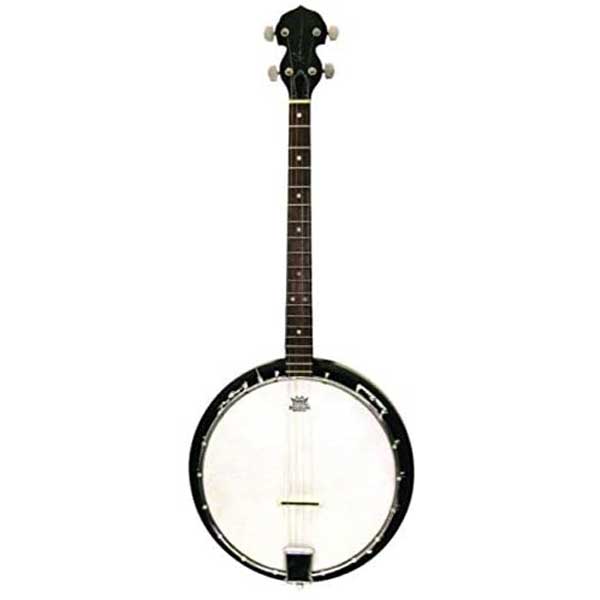
| Estimated Price | $260 |
| Banjo Style | 4 string tenor |
| Top | Mora |
| Back and Rim | Nato |
| Neck | Mora |
| Finish | Black |
| Fret Count | 19 |
| Country of Origin | USA |
My Review: Trinity River Music is an instrument maker out of Texas, again they don’t share that much info on social media pages. This 4 string tenor banjo has a resonator, unlike most tenors. If you want a 4 string tuning or sound but with a lot of projection and volume, this could possibly be the banjo for you.
The reviews are not overly satisfied nor are they terrible; they seem to be a company building a decent reputation. For this price, you should get a solid build and decent intonation. Of course make sure you don’t want a 5 string, because if you do spend a little bit more and get that.
Key Features: It is a whopping 43 inches and 8 pounds. It has 18 brackets, a Remo head, open tuners, and it comes with a custom gig bag.
Build Materials: The neck wood is mora and the resonator is nato.
Who Will Use This the Most: Folks who want tenor banjo tunings with a resonator.
Bottom Line: As long as you check it thoroughly when you get it this instrument should be a great beginner tenor banjo.
20. Luna Celtic 5 String
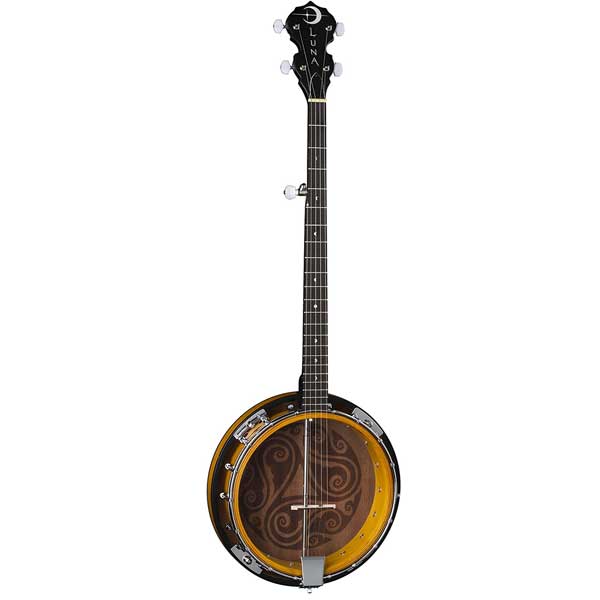
| Estimated Price | $400 |
| Banjo Style | 5 string with resonator |
| Top | Mahogany |
| Back and Rim | Mahogany |
| Neck | Mahogany |
| Finish | Tobacco burst |
| Fret Count | 22 |
| Country of Origin | Korea |
My Review: We will end with a beautiful banjo made by a ukulele maker! Luna is mostly known for making Hawaiian tattoo designed ukuleles. They usually have interesting color combinations just like this banjo which is tobacco burst. They have a solid reputation as instrument builders so there should be no worries about their banjo quality.
At this price you are going to get a nice solid 5 string banjo with a resonator that sounds great, what matters is if you like this look or not. In its short time, it is already getting great reviews and selling out fast. You definitely want to get a case for such an expensive banjo. It is labeled a Celtic banjo but there is nothing that makes it Celtic save for the design and tuning you play on it.
Key Features: The product dimensions are likely wrong on this page but given the scale of the fretboard it is average banjo size. With Pearloid gears and moon phase inlays As usual it also has a laser-etched Luna design.
Build Materials: The neck and body are mahogany while the fretboard and bridge are black walnut. It has a Remo head with 24 chrome brackets and a dual action truss rod.
Who Will Use This the Most: Buyers who want a normal and nice sounding 5 string banjo with a very unique look.
Bottom Line: If this finish, design, and budget all appeal to you, the Luna will make a great banjo.
Choosing the Right Banjo for Beginners (Buying Guide)
No matter what instrument you buy you should always do some research before you make a purchase. The more informed you are the better chance you have of finding a great banjo. If you know the basic banjo anatomy and the main parts it might help you avoid buying one that is too cheap and not playable.
Banjo Sizes and Tuning
Open Back Vs. Resonator: All of the sizes and string amounts below can have a wood resonator or an open back. The point of a resonator in musical instruments is to increase the volume and tone. The banjo is rather loud just as an open back, add the resonator and it can carry far off stage. If you are new an open back is nice because it is lighter and less awkward. But if you buy one with a resonator you can usually take it off. So you have the best of both worlds.
5 String: Most banjos, especially associated with bluegrass, are 5 strings. With four strings that are long and one on the top that is a little over half as short as the others. This 5th string is there as a drone string to be incorporated into your rolls and picking. 5 strings can also come in various sizes from a short parlor neck to an extra-long neck and fretboard. The common tuning for most large 5 strings is GDGBG, which is an open G chord. This tuning makes it very easy to learn where chords and notes are.
4 String: These banjos do not have the little halfway down the neck short string. They can have a variety of tunings including GDAE like a mandolin which is used for Irish folk music. They are also great for Dixieland and other traditional folk music. The 4 strings are usually open back but might have resonators. They can also come in various scale sizes.
Plectrum: Slightly smaller 4 stringed banjos played with a pick. They use more old-time tunings like C, G, B, D, and sometimes D, G. B, E (like a baritone ukulele). It is commonly used for folk music and traditional jazz.
Hybrid/6 Strings: This is a mix of a guitar and banjo, made for guitarists switching over to banjos. The tuning is the same so it is EADGBE. It usually looks like a guitar fretboard attached to a banjo head. If you are going for that particular sound, go for it. But for most beginners, a 5 or 4 string will be a better idea.
You don’t often see electric banjos except for occasional unique hybrids (Like the Gold Tone EBM5). If you want to amplify your banjo you generally just add a nice pickup to the back, top, or bridge depending on your budget. Plus the banjo is already loud. You should learn to play better before you amplify it less a neighbor or family member snaps. It has happened.
Banjolele/ Banjolin: A banjolele is a mix of a ukulele size and tuning with the banjo head. The same with a banjolin otherwise known as a banjo mandolin. While most aren’t shopping for these it is good to know in case you luckily come across one. They are fun to play! (Often old banjo mandolins aren’t playable anymore from tension so be careful if you get the bug to buy one).
Banjo Parts and Materials
While there isn’t much wood in the body of the banjo (without a resonator) it still makes a big difference in how it sounds. In stringed instruments, laminated wood is cheaper and doesn’t sound as good as solid wood. With the banjo, we are dealing with both wood and metal materials that affect the tone and volume. Your budget will make all the difference in whether those materials are good or not.
Neck and Peghead: On the banjo, we call the headstock the peghead, and where it connects to the neck is where the nut holds the strings. The tuning gears are in the peghead, allowing us to tighten the strings. The neck is often made of mahogany or maple and links the body (or pot) and peghead. If it is a 5 string banjo the 5th tuner and string are attached almost halfway down the neck.
Fretboard: On the neck is a fretboard most often made of rosewood with the number of metal frets necessary for the model. Right before the frets are where your fingers go to play the notes. A truss rod runs down the center of the neck and through the banjo rim. This truss rod gives the neck stability and can be adjusted if it bows.
Rim: The main round wooden part attached to the neck is the rim and depending on the money your banjo costs it may be reinforced with steel and small rods. Maple is a common wood used for rims. The more solid the wood the better the banjo will sound. The bolts that attach the rim to the neck sometimes needs to be tightened as they can become loose and affect the sound.
Tone Ring: The tone ring sits above the rim, but below the banjo head. Again the price of the banjo will depend on what material is used, but rolled brass is very common. The tone ring adds volume and sustain. As the banjo head vibrates it transfers the sound waves to the loop and the rim.
Banjo head: The sound you make after plucking a string goes into the bridge and then into the head. A long time ago they were made of animal skin, but now it is usually mylar. Not only does the thickness of the mylar make a difference it also matters how high the mylar is from where it attaches to the rim. This “crown height” is usually high or medium in the best banjos.
Hoop/Brackets: There is a tension hoop placed over the mylar head and then held into place with 16 or more brackets, up to 30 on some large models. If you have a banjo with a resonator it will have a flange. This flange is what attaches the resonator to the rim and pot assembly.
Resonator: The resonator is also often made of mahogany or maple and it projects the sound of the banjo. Usually, it connects with a few lugs and is easy to remove. Some players take it off to stuff a soft fabric in there to mute the loud sound for practice. An open back banjo will not have a resonator and usually no way to attach one.
Bridge: The most important thing to know about the banjo bridge is that it’s adjustable. And there will be times that you may need to place it in the right spot on the banjo head. Where you place it will greatly affect the intonation so follow the instructions carefully. (When a banjo isn’t set up for you they will leave the instructions, and it can also be found online). One way to make a moderately priced banjo sound better is to buy a higher quality bridge and strings.
Tailpiece: The tailpiece connects the strings that go from the tuners in the peghead all the way to the bottom of the rim. It may seem trivial but it is an important piece. If it is made from cheap metals, it can vibrate and make noises that you don’t want. You will often see cheap banjos with felt or fabric stuffed in there to stop a rattle. Sometimes it even happens on the high budget models.
Types of Strings
If you play any stringed instrument the strings you choose are very important. After you get some of the basics down you will want to change your strings and try new brands. Find out what materials and styles make your banjo sing. Banjo strings are usually pretty cheap. Here are the main kinds of strings that will be available.
Stainless Steel: Most of the strings you will see are steel, these are the lowest priced and give the sound many players want from a banjo.
Nickel Plated Steel: By plating the steel with nickel it often gives lower notes a warmer tone.
Some players like steel for the high notes and nickel plated for the low ones.
Phosphor Bronze: This copper alloy is used for making the body of brass instruments, saxophones, and even to wrap strings! These strings are very resilient with higher sustain.
Coated: This is when string makers wrap nickel, steel, or some other alloy in polymer coating. It is done to increase tone and feel better on the fingers. These are the more expensive banjo strings and some sound incredible.
10 Tips for Buying a Banjo
Being cheap will get you nowhere. This goes for buying any instrument or anything at all. As a first time or recent player, you do not have the skill to tell the difference in a great score and being ripped off. There are a ton of instruments sold these days at super cheap prices and they are usually not worth buying. The intonation is not right leaving the player to believe they can’t learn to play it. A great price for a first-time banjo is $500 and up, but if that is too steep you shouldn’t go lower than the $300 range for a 5 string with a resonator.
Buying online is just as good as locally. There has always been a push to buy locally but for many, that option is disappearing or does not exist. The banjo is not exactly as popular and stocked as the guitar or ukulele. If you have a nice local shop then of course order through them and even have a setup. Online you can either order from the large music retailers or directly from the maker, but that usually costs more.
Accessories are essential! If you are spending a few hundred dollars on a banjo you really need to get a case that will run at least $50. And easily $100 for a good hard-shell to protect a nice banjo. It is also necessary to have a strap and an armrest sure saves a lot of discomforts. Some banjos dig in your arms and sometimes skin reacts to metal, especially on cheaper banjos.
Read reviews when you find the ones you like. The examples below are all mostly great first time banjos from a variety of popular brands. But look beyond these models and see exactly what a company can offer. When you find the instrument you like, see what others have to say about it. Avoid overly positive or negative feedback (unless it’s a lot!) and focus on the substance of user reviews.
Don’t worry too much about musical styles if you are not sure. Yes, certain banjo styles, scale lengths, and 5th drone strings suit different genres, but you can play almost anything you want if you practice and study at it. One of the great things about a 5 string banjo with a resonator is you can usually take the 5th string and resonator off. The lost string won’t affect the intonation enough to hurt the sound. And voila you have a 4 string.
Inspect the build when you buy it or receive it in the mail. Look at the neck, the tuners, and all of the body to be sure nothing is wrong. Make sure it stays in tune if there is drastic movement in the note that is a problem. If any metal is unglued or wood coming apart that definitely needs to go back. Unfortunately, some issues may not be apparent on the first inspection and play.
Look at the action. This is how far the strings are from the fretboard. They are closer by the nut and get slightly higher as we move towards the bridge. If they are too low they will buzz when you fret a note. Too high and it will be a pain in the banjo neck to fret a chord. Bad action is a common source of failure, fingers end up hurting far more than they should.
Check the Intonation. We have mentioned this, and it is important to explain it. If you play the D string when it is open it should be tuned to D. When you play the next fret it should be D#/Eb, E, F, and so on up the scale. In cheaper banjos, it won’t be perfect, but if it is too far off none of your chords will sound right. Sometimes adjusting the bridge can fix this, but not if the build is poor.
Be prepared for noise. It is hard to start playing banjo because it is so damn loud and it makes one crazy self-conscious. There are bridge mutes and you can stuff fabric in the resonator, some of these methods will also be used to have a quiet practice and not annoy other people. Depending on your living situation you may need to dampen the sound a little. Banjos stand out so much that they often drown other instruments out on stage!
So there you not only have some of the best banjos on the market, but you also know every major brand now. Once you finally have the banjo in your hands it is time to start watching videos and learning the specific style of music that has grabbed your attention! The banjo is a wonderful instrument to play, just be patient, persistent, and practice all the time! Good luck!

My name is Chris and I’ve had a passion for music and guitars for as long as I can remember. I started this website with some of my friends who are musicians, music teachers, gear heads, and music enthusiasts so we could provide high-quality guitar and music-related content.
I’ve been playing guitar since I was 13 years old and am an avid collector. Amps, pedals, guitars, bass, drums, microphones, studio, and recording gear, I love it all.
I was born and raised in Western Pennsylvania. My background is in Electrical Engineering, earning a Bachelor’s degree from Youngstown State University. With my engineering experience, I’ve developed as a designer of guitar amplifiers and effects. A true passion of mine, I’ve designed, built, and repaired a wide range of guitar amps and electronics. Here at the Guitar Lobby, our aim is to share our passion for Music and gear with the rest of the music community.
